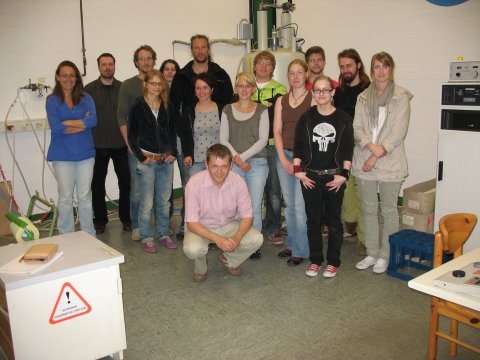Report of the 11. DMG Shortcourse "Applications of Solid State NMR Spectroscopy in the mineralogical and geoscientific research "
in Bochum from 14. – 17. June 2011

The DMG/DGK Shortcourse ”Applications of Solid State NMR Spectroscopy in the Mineralogical and Geoscientific Research” was held at the Ruhr-Universität Bochum from 14th - 17th June 2011. Dr. Michael Fechtelkord who was in charge teached the basics of solid state NMR spectroscopy in the eleventh edition of this course. A noticeable perfected programme offered extensive insights into the subject and made it possible for the 16 participants to gain a maximum of knowledge. The morning theory hours were accompanied by NMR experiments in the afternoon. On the one hand the theoretical concepts could be repeated again briefly. On the other hand the operation of an NMR spectrometer was exciting new ground for most participants. The subsequent evaluation of the spectra was carried out in small groups.
Thus, in the context of the workshop the complete experimental way could be reconstructed from sample preparation to spectra evaluation. The selection of the provided samples covered a large range of the theoretically explained phenomena:
Following the explanation of basics of NMR spectrometer operation in the morning of the first course day, the first exercise, consisted of the variable temperature spectra acquisition of tetramethylammoniumiodide for the afternoon. The evaluation yielded the activation energies of the different dynamic processes.
Starting with the second theory block in the following morning the emphasis was shifted increasingly on MAS NMR spectroscopic problem definitions. Thus, in the afternoon NMR spectra of different spin-1/2-nuclei in phlogopite (1H, 19F, 29Si) were evaluated. Moreover, simple spectra were fitted by means of the DMFit2011 program.
On the third course day possibilities of multi-pulse techniques (e.g., CPMAS, INADEQUATE) and their abilities were introduced. In the afternoon session the average H-Si-distance in kaolinite was determined from a CPMAS experiment. In addition increasing complex spectra were evaluated with the DMFit2011 program.
The last workshop day was dedicated to the quadrupolar nuclei. The conception of different experiment procedures was followed by an introduction to the topic such as DOR, MQMAS or SATRAS. In connection 23Na-MAS and 27Al-SATRAS-NMR-experiments were carried out, which were evaluated in the last block of the workshop.
Summarizing, the workshop offered a balanced mixture of theory and practical work and created numerous incentives to occupy oneself with the demanding method of MAS NMR spectroscopy more intensively.
Speaking for all participants we would like to thank Michael Fechtelkord again for the successful shortcourse, and besides that for the organization of evening activities like “Icebreakerparty” and Bowling, which offered the opportunity to get to know each other of the participants and arranged a still more pleasant atmosphere.
Anna Hauschild (Kiel) and Michael Jehle (Freiburg i. Br.)


